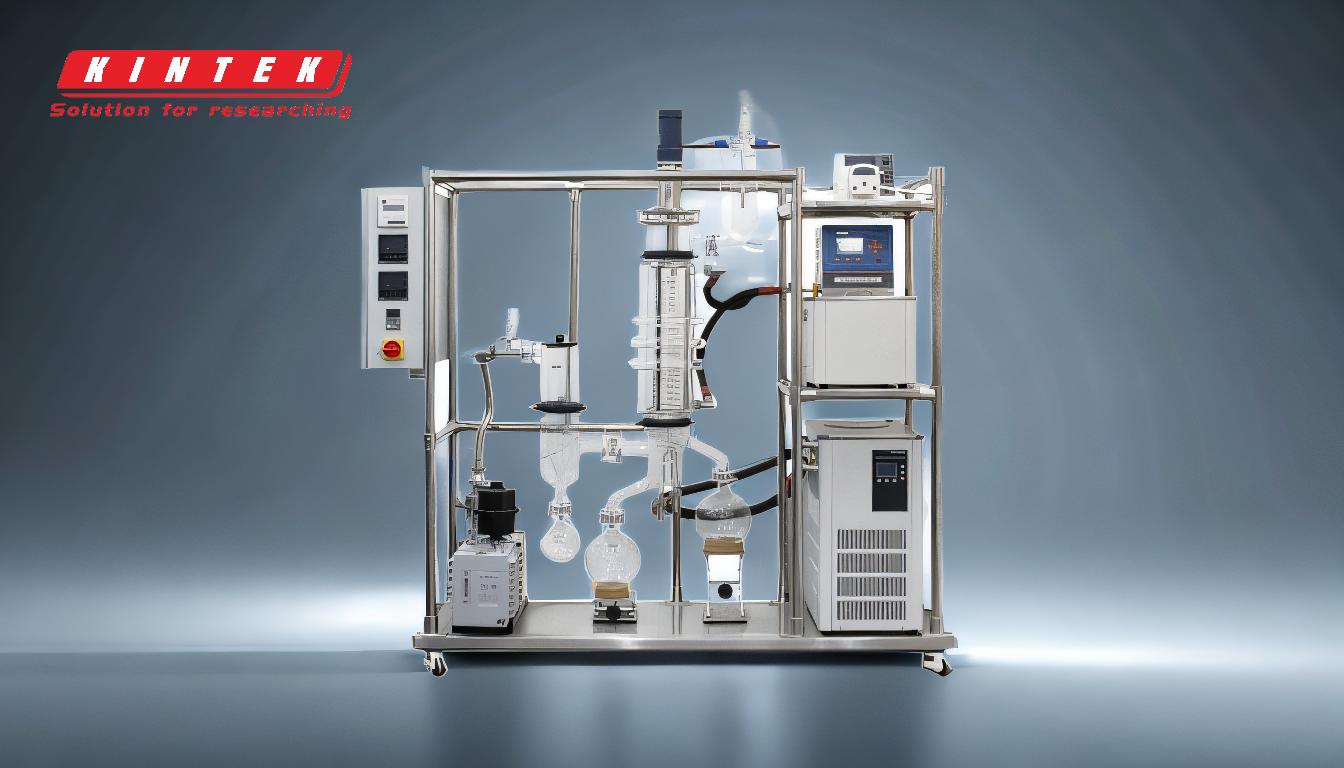Molecular distillation is a specialized separation process that operates under extremely low vacuum pressure (typically 0.01 torr or below) and high temperatures. It is designed to purify and concentrate thermally sensitive compounds, such as vitamins, polyunsaturated fatty acids, and other natural products, by minimizing thermal degradation. The process leverages the principle of mean free path, where molecules travel a short distance without colliding, allowing for efficient separation based on their individual properties. This method is particularly effective for complex mixtures with high boiling points or heat-sensitive components, offering a high level of purity and concentration while reducing energy consumption.
Key Points Explained:

-
Definition and Purpose of Molecular Distillation:
- Molecular distillation is a short-path vacuum distillation technique used to separate, purify, and concentrate thermally sensitive compounds.
- It is particularly effective for substances that are unstable at high temperatures or have high boiling points, such as vitamins, essential oils, and polyunsaturated fatty acids.
- The process is widely used in industries like pharmaceuticals, food processing, and cosmetics to obtain high-purity products.
-
Operating Conditions:
- High Vacuum Pressure: Operates at extremely low pressures (0.01 torr or below), which significantly lowers the boiling points of substances, reducing the energy required for heating.
- High Temperatures: Despite the high temperatures, the low pressure ensures minimal thermal degradation of sensitive compounds.
- Short Distance Between Evaporator and Condenser: The vapor travels a very short distance (about 2 cm) before condensing, minimizing losses and ensuring efficient separation.
-
Principles of Molecular Distillation:
- Mean Free Path: The process relies on the principle of mean free path, where molecules travel without colliding due to the high vacuum. This allows for separation based on the individual mean free paths of the molecules.
- Minimal Vapor/Liquid Interface: The short distance between the evaporator and condenser ensures minimal interaction between vapor and liquid, reducing the risk of contamination or degradation.
-
Steps in the Molecular Distillation Process:
- Formation of a Liquid Film: The material forms a thin liquid film on the heating surface.
- Free Evaporation: Component molecules evaporate freely from the surface of the liquid film.
- Movement to Condensing Surface: The evaporated molecules travel a short distance to the condensing surface.
- Condensation: The molecules condense on the cool condensing surface.
- Collection: The distillates (purified components) and residues are collected separately.
-
Advantages of Molecular Distillation:
- High Purity: Achieves a high level of purity by minimizing contamination and thermal degradation.
- Energy Efficiency: The low pressure reduces boiling points, lowering the energy required for heating.
- Suitable for Heat-Sensitive Compounds: Ideal for processing thermally unstable or sensitive substances.
- Scalability: Can be adapted for both laboratory-scale and industrial-scale applications.
-
Applications of Molecular Distillation:
- Pharmaceuticals: Purification of vitamins, hormones, and other sensitive compounds.
- Food Industry: Concentration of omega-3 fatty acids, essential oils, and natural extracts.
- Cosmetics: Extraction and purification of natural ingredients for skincare products.
- Chemical Industry: Separation of complex mixtures with similar boiling points.
-
Comparison with Traditional Distillation:
- Molecular distillation operates under much lower pressures and shorter distances compared to traditional distillation, making it more suitable for heat-sensitive compounds.
- Traditional distillation often requires higher temperatures and longer processing times, increasing the risk of thermal degradation.
-
Challenges and Considerations:
- Equipment Cost: Molecular distillation equipment can be expensive due to the need for high vacuum systems and precise temperature control.
- Maintenance: The process requires regular maintenance to ensure optimal performance and prevent contamination.
- Complexity: The process is more complex than traditional distillation, requiring skilled operators and careful monitoring.
In summary, molecular distillation is a highly effective separation technique for purifying and concentrating thermally sensitive compounds. Its unique operating conditions and principles make it indispensable in industries where high purity and minimal thermal degradation are critical.
Summary Table:
| Key Aspect | Details |
|---|---|
| Definition | A short-path vacuum distillation technique for purifying sensitive compounds. |
| Operating Conditions | - High vacuum pressure (≤ 0.01 torr) |
| - High temperatures with minimal degradation | |
| Principles | - Mean free path |
| - Minimal vapor/liquid interface | |
| Advantages | - High purity |
- Energy efficiency
- Scalability for lab and industrial use | | Applications | Pharmaceuticals, food processing, cosmetics, and chemical industries. | | Challenges | High equipment cost, maintenance, and operational complexity. |
Discover how molecular distillation can optimize your processes—contact us today for expert advice!









